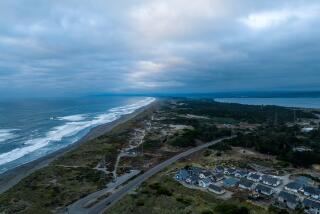Editorial: How to cool an increasingly hot city
- Share via
Los Angeles street services crews have begun slathering a new light gray coating on some boring old black asphalt streets. They’re not just changing the color scheme. The city is testing whether so-called cool pavements can lower the temperature in the surrounding area and help counter the effects of global warming.
For a decade California has launched some of the world’s most ambitious programs to cut greenhouse gas emissions in an attempt to slow climate change. But in a shift driven by the stark reality that the planet is already warming, there are more projects in the state, like the cool streets experiment, aimed at preparing communities for the now-inevitable impacts of climate change.
Santa Monica, for instance, has planted native dune plants on three acres of sand to test whether beach restoration could help protect coastal development from rising sea levels and storm surges. Los Angeles and other cities have begun requiring lighter colored roofs to reflect sunlight and reduce the urban heat island effect that causes developed areas to be hotter than open spaces.
What’s driving the focus on climate change adaptation? Communities are already having to deal with the effects of more extreme weather patterns. Several years of severe drought were followed this year by one of the wettest winters in a century, which led to floods and landslides. Wildfire seasons have grown longer and more destructive. Changes in seawater temperatures are affecting fisheries and water quality.
If the city can fix the streets and lower the urban temperature at the same time, that’s an infrastructure twofer.
And researchers suggest the impacts will only get more serious. Scientists say glaciers and sea ice in the Arctic are melting faster than expected, meaning that sea levels are also likely to rise faster than predicted.
In California, that means more frequent flooding in low-lying areas and more destructive waves that could wipe out roads, train tracks and development along the coast. Without intervention, up to 67% of the state’s beaches could be lost to sea level rise and erosion by the end of the century, according to recent modeling by the U.S. Geological Survey.
The news is just as worrisome for inland Californians. The number of extremely hot days — those over 95 degrees — could triple or quadruple by 2050, UCLA scientists forecast. Such temperatures can worsen existing health conditions such as diabetes, and can be deadly to residents without air conditioning.
So while California presses ahead on greenhouse gas emissions reductions to help the global fight against climate change, localities have to confront the very real problems at their doorstep. Starting this year, cities and counties are required by state law to study and develop policies to address the risks that climate change poses to their communities. For example, communities vulnerable to more frequent wildfires could have to evaluate whether new homes can be built safely on the urban edge.
In Los Angeles, rising temperatures pose a real risk to residents in the hottest communities. The city has to explore more ways to dissipate the heat rising off of asphalt streets. That’s why the city’s cool pavement test is particularly smart: Los Angeles is going to be repaving lots of the city’s streets in the coming years, thanks to new, transportation-dedicated revenues from increased sales taxes and fuel taxes. If the city can fix the streets and lower the urban temperature at the same time, that’s an infrastructure twofer.
And yet, L.A.’s cool pavement project also demonstrates why progress in climate adaptation is so challenging for cities and counties, and so frustratingly slow. It took the Bureau of Street Services four years to go from idea to execution. Four years! The bureau had to find a commercially available cool pavement product and, since there were no examples of publicly-traveled cool streets in California, they had to test it for durability, as well as skid and slip potential.
So far, most of the climate-change-related technological advances and regulations have been focused on reducing greenhouse gas emissions. Rightfully so — the world must act quickly to slow climate change if it is to reduce the predicted damage from rising temperatures. But there’s also a tremendous need for creativity, funding and innovation to help communities adapt to the change we’re already seeing and the change we are expecting in the years ahead.
Follow the Opinion section on Twitter @latimesopinion and Facebook
More to Read
A cure for the common opinion
Get thought-provoking perspectives with our weekly newsletter.
You may occasionally receive promotional content from the Los Angeles Times.






